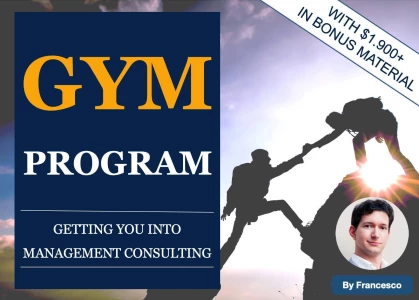Hi, I have a 90min Case study Interview with EY (Supply Chain Consulting) - UK.
Any ideas on what to expect and how to prepare?
Will this be an Interviewer led case study or a written case study format?
Thanks
Hi, I have a 90min Case study Interview with EY (Supply Chain Consulting) - UK.
Any ideas on what to expect and how to prepare?
Will this be an Interviewer led case study or a written case study format?
Thanks


Hi there,
Given your comment below on Adi’s reply, it is going to be a written case/panel.
The key areas you will have to cover to prepare for that interview are the following.
1. Learn how to define a plan of action and stick to that
The first thing you should do in a written case is to define a plan and allocate your time in the best possible way.
Assuming 30 minutes for the analysis, a good approach would include:
You should practice to stick to the time allocated to maximize your final performance.
2. Practice graph interpretation
You will probably have to analyze graphs as part of the data provided. The best way to practice is to take graphs from online sources and use a timer to test in how much time you can understand the key message. McKinsey PST graphs are good practice for that.
3. Work on quick reading and quick understanding of key information
You won’t have time to read and prioritize everything, therefore you have to understand where to focus. The ideal way to practice is to use long cases such as HBS ones. You should then learn to absorb the key information of the case. Quick reading techniques could also help.
4. Practice quick math
You will probably have some math to do as part of the data analysis. GMAT and McKinsey PST math should work well to prepare for this.
5. Learn how to communicate your slides/answers
When you have to present your findings in the second part, I would suggest the same structure used for a conclusion in a live interview, that is:
As you will not be able to double-check hypotheses with the interviewer while you prepare the presentation, you should clearly state when you are making hypotheses and that you will have to verify them with further analysis.
When you have to prepare slides I would also recommend to work on:
A) Structure the order of the slides
Normally the structure for a 5-slide presentation is the following:
B) Structure the content of each slide
There are three basic components for slides:
Many people structure the title as the mere description of what the chart is about.
A great title instead shows the implication of the graph as well.
Example: say the graph is showing a cost structure for a division.
The rule of thumb for the title is that if you read all the titles of the slides together you should get a clear idea of what is going on.
C) Present the slides
When you present, I would suggest the following steps for each slide:
In terms of how to prepare, I do a session exactly on that.
Before the session, I can send you the data source to work on. We can then simulate the written case during the class, reviewing step-by-step all the improvements needed.
Please feel free to send me a message in case you have any questions.
Best,
Francesco

Hey there,
You will face a written case. Here are a few tips for this situation:
#1 Already have a plan when you go in for the written case
Since time is usually limited, you should have a plan on how long you want to spend on each task of the assignment beforehand.
#2 Focus – quickly separate crucial information from the noise
Written cases usually present you with an information overload that you need to sort out
#3 Graphs and charts – interpret and distill key insights from graphs and charts
Written cases bombard you with charts, graphs, tables, and other visual depictions of data that you should use to test your hypotheses. Learn how to quickly read and interpret them
#4 Math – quickly draft equations and conduct pen-and-paper math
Get into the habit of quickly setting up and simplifying calculations
#5 Storyline – draft a compelling storyline and tell it with visually appealing outputs
Create a top-down storyline of your recommendations. State your primary recommendation, then use supporting arguments to strengthen your position
#6 Presentation and defense – communicate and defend your recommendation top-down
If you have to present your findings at the end of the case, follow the top-down approach of your slide deck. Be confident and engaging when going through your recommendation and supporting arguments.
I have written in great detail about the written case interviews in this free article here: https://strategycase.com/how-to-crack-written-case-interviews
All the best!
Cheers,
Florian

Hi there,
This very much sounds like a written case study.
It's unfortunate because there really aren't many practice cases out there :/
That said, I have a number I'd be more than happy to share with you! What I generally do with my candidates is, give them a written case x hours before our scheduled session (adjust # of hours based on the specific interview they're going to have), and then review their work during the session (as well as talk through tips+tricks to get better).

Hey,
Dont hesitate to clarify details with HR such as written case or interviewee led.
Have you applied for an experience hire role in their consulting practice?
Supply Chain is my specialty so feel free to message to discuss if you need any prep help.
There are plenty of threads in the Q&A forum on case interview prep so please search broadly for that.

Hello!
This are precisely the questions that HR should adress happily.
Cheers,
Clara

Hi there,
I agree - you should probably prepare for the written case. The other coaches gave you very good hints on how to approach it the best way.
Cheers, GB

Hi,
I confirm it will be a written case. The preparation will be the classical one with 2 additional points to focus on:
I have a couple of well done written cases, feel free to text me for sharing.

Do reach out to their internal Talent team to get answers on the structure of the case as they should have offered this information
Preparation should be similar to other Big 4 cases which you can find on the Preplounge case library











